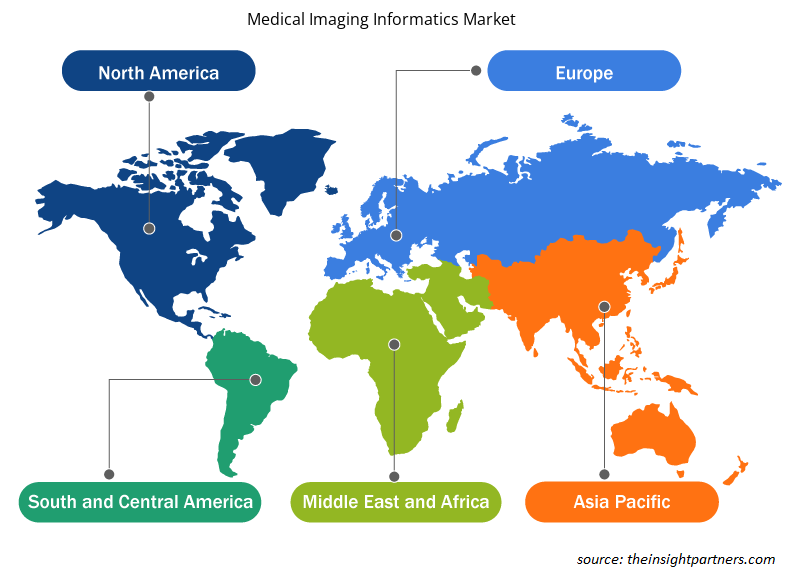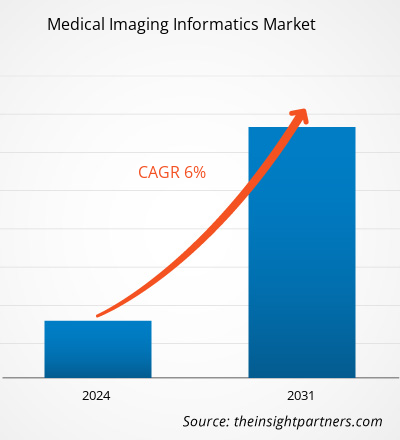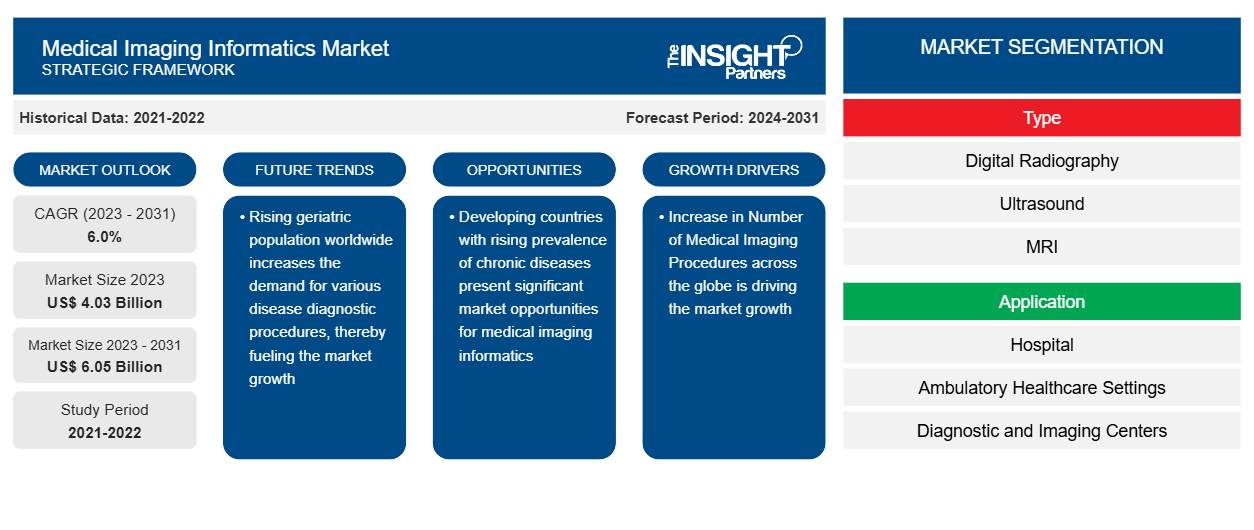Se proyecta que el tamaño del mercado de informática de imágenes médicas alcance los 6.050 millones de dólares estadounidenses para 2031, desde los 4.030 millones de dólares estadounidenses en 2023. Se espera que el mercado registre una CAGR del 6,0 % durante 2023-2031.La creciente demanda de plataformas basadas en IA y en la nube probablemente seguirá siendo una tendencia clave en el mercado.
Análisis del mercado de la informática para imágenes médicas
Los factores clave que impulsan el crecimiento del mercado son el creciente número de procedimientos de diagnóstico por imágenes y el aumento de la población geriátrica. Además, los avances tecnológicos en informática de diagnóstico por imágenes han creado oportunidades de crecimiento para el mercado durante el próximo período de pronóstico.
Descripción general del mercado de informática para imágenes médicas
Según el motor de búsqueda clínica Radiology Key, la informática de imágenes implica el uso de tecnología de la información (TI) para brindar servicios de imágenes médicas eficientes, precisos y confiables dentro de una red de atención médica. También conocida como informática radiológica, la informática de imágenes médicas es responsable de almacenar, administrar y acceder a información y datos relacionados con imágenes. Las imágenes médicas se utilizan ampliamente en aplicaciones de cardiología, obstetricia, cirugía y ginecología, entre otras, en el sector de la atención médica. Además del aumento en los diagnósticos, un énfasis creciente de los gobiernos regionales y nacionales en el diagnóstico temprano de afecciones médicas para reducir los costos generales de la atención médica está impulsando el número de pacientes que se someten a imágenes por resonancia magnética (IRM), tomografía computarizada (TC), ecografías y exploraciones de rayos X en todo el mundo, lo que refuerza la necesidad de informática de imágenes médicas.
Personalice este informe según sus necesidades
Obtendrá personalización en cualquier informe, sin cargo, incluidas partes de este informe o análisis a nivel de país, paquete de datos de Excel, así como también grandes ofertas y descuentos para empresas emergentes y universidades.
-
Obtenga las principales tendencias clave del mercado de este informe.Esta muestra GRATUITA incluirá análisis de datos, desde tendencias del mercado hasta estimaciones y pronósticos.
Factores impulsores y oportunidades del mercado de la informática para imágenes médicas
Aumento de la población geriátrica
El Reino Unido, Canadá, Japón, China, India y Corea del Sur, entre otras economías, han modernizado considerablemente sus instalaciones y servicios de atención sanitaria. Como resultado, la esperanza de vida de las personas en estos países ha aumentado, lo que ha llevado al crecimiento de su base de población geriátrica. Según datos de la OMS, en 2019, el número de personas de 60 años o más era de 1.000 millones, y es probable que aumente a 1.400 millones en 2030 y 2.100 millones en 2050. La población de edad avanzada sufre principalmente diversas enfermedades crónicas, como las enfermedades cardiovasculares (ECV), debido a los cambios estructurales y funcionales en sus sistemas cardiovasculares asociados con el envejecimiento. El envejecimiento conduce al endurecimiento del corazón y los vasos sanguíneos. Por lo tanto, las arritmias, así como la enfermedad de las arterias coronarias y la insuficiencia cardíaca, son factores de riesgo comunes en las personas de 75 años o más. En la actualización estadística de 2019 sobre enfermedades cardíacas y accidentes cerebrovasculares de la Asociación Estadounidense del Corazón (AAH), la incidencia de ECV fue del 77,2 % en hombres y del 78,2 % en mujeres del grupo de edad de 60 a 79 años. Además, la incidencia de ECV fue del 89,3 % en hombres adultos y del 91,8 % en mujeres adultas de 80 años o más. Por lo tanto, el aumento de la población geriátrica en todo el mundo aumenta la demanda de diversos procedimientos de diagnóstico de enfermedades y de informática de imágenes médicas, lo que impulsa el crecimiento del mercado.
Panoramas dinámicos de la atención sanitaria en China y la India
Los países en desarrollo, como China y la India, presentan importantes oportunidades de mercado para la informática de imágenes médicas. Con el crecimiento de la población, el aumento de los gastos sanitarios y la creciente prevalencia de enfermedades crónicas, existe una creciente demanda de tecnologías avanzadas de imágenes médicas en estos países. La adopción de sistemas de imágenes digitales y soluciones informáticas está aumentando en China y la India, impulsada por la necesidad de una gestión eficiente de los datos, una mayor precisión diagnóstica y una mejor atención al paciente. En China, las iniciativas del gobierno para modernizar la infraestructura sanitaria y mejorar el acceso a servicios sanitarios de calidad han llevado a una mayor adopción de soluciones informáticas de imágenes médicas. La gran población del país y el sector sanitario en expansión proporcionan un vasto mercado para los proveedores que ofrecen tecnologías avanzadas de informática de imágenes . En la India, el creciente número de centros sanitarios, junto con la creciente conciencia de los beneficios de las imágenes digitales, está impulsando la demanda de soluciones informáticas que puedan agilizar los flujos de trabajo y mejorar la toma de decisiones clínicas. Al aprovechar estas oportunidades y abordar las necesidades específicas de estos mercados, los proveedores pueden aprovechar el enorme potencial de crecimiento que ofrecen estos países en desarrollo.
Informe de mercado de informática de imágenes médicas Análisis de segmentación
Los segmentos clave que contribuyeron a la derivación del análisis del mercado de informática de imágenes médicas son el producto y el usuario final.
- Según el tipo, el mercado de la informática de imágenes médicas es la radiografía digital,Ultrasonido, resonancia magnética, tomografía computarizada, imágenes nucleares, mamografía. El segmento de ultrasonidos tuvo la mayor participación de mercado en 2023.
- Según la aplicación, el mercado de la informática para imágenes médicas está segmentado por hospitales, centros de atención médica ambulatoria, centros de diagnóstico e imágenes, entre otros. El segmento de hospitales tuvo la mayor participación de mercado en 2023.
- Según los componentes, el mercado de la informática para imágenes médicas está segmentado por software, hardware y servicios. El segmento de software tuvo la mayor participación de mercado en 2023.
Análisis de la cuota de mercado de la informática para imágenes médicas por geografía
El alcance geográfico del informe de mercado de informática de imágenes médicas se divide principalmente en cinco regiones: América del Norte, Asia Pacífico, Europa, Medio Oriente y África, y América del Sur y Central.
En América del Norte, Estados Unidos es el mayor mercado de informática para imágenes médicas. Se espera que este mercado crezca significativamente debido a la creciente prevalencia del cáncer, la creciente demanda de imágenes diagnósticas y el crecimiento de la población geriátrica en todo el país. Además, se espera que los diversos avances realizados por los principales actores del mercado en el país y el aumento de la inversión gubernamental para promover la industria de dispositivos médicos también impulsen el crecimiento del mercado durante el período de pronóstico.
En Estados Unidos y en todo el mundo, el cáncer tiene un impacto significativo en la sociedad. Las estadísticas sobre el cáncer muestran lo que ocurre en grandes grupos de personas y brindan una instantánea del impacto de la enfermedad en la sociedad a lo largo del tiempo. Según Globocan 2020, en Estados Unidos hubo 2.281.658 nuevos casos de cáncer, lo que representó 612.390 muertes. Los tipos de cáncer más comunes en el país son el cáncer de mama, el cáncer de pulmón, el cáncer de próstata, el cáncer colorrectal y otros. Por lo tanto, se espera que la creciente prevalencia del cáncer en el país impulse la demanda de herramientas de imágenes médicas como ecografías, resonancias magnéticas, radiografías digitales y computarizadas, etc. La demanda de informática de información médica también florecerá durante el período de pronóstico.
Perspectivas regionales del mercado de informática para imágenes médicas
Los analistas de Insight Partners explicaron en detalle las tendencias y los factores regionales que influyen en el mercado de informática de imágenes médicas durante el período de pronóstico. Esta sección también analiza los segmentos y la geografía del mercado de informática de imágenes médicas en América del Norte, Europa, Asia Pacífico, Oriente Medio y África, y América del Sur y Central.

- Obtenga datos regionales específicos para el mercado de informática de imágenes médicas
Alcance del informe de mercado de informática para imágenes médicas
| Atributo del informe | Detalles |
|---|---|
| Tamaño del mercado en 2023 | US$ 4.03 mil millones |
| Tamaño del mercado en 2031 | 6.050 millones de dólares estadounidenses |
| CAGR global (2023 - 2031) | 6.0% |
| Datos históricos | 2021-2022 |
| Período de pronóstico | 2024-2031 |
| Segmentos cubiertos |
Por tipo
|
| Regiones y países cubiertos |
América del norte
|
| Líderes del mercado y perfiles de empresas clave |
|
Densidad de actores del mercado de informática para imágenes médicas: comprensión de su impacto en la dinámica empresarial
El mercado de la informática para imágenes médicas está creciendo rápidamente, impulsado por la creciente demanda de los usuarios finales debido a factores como la evolución de las preferencias de los consumidores, los avances tecnológicos y una mayor conciencia de los beneficios del producto. A medida que aumenta la demanda, las empresas amplían sus ofertas, innovan para satisfacer las necesidades de los consumidores y aprovechan las tendencias emergentes, lo que impulsa aún más el crecimiento del mercado.
La densidad de actores del mercado se refiere a la distribución de las empresas o firmas que operan dentro de un mercado o industria en particular. Indica cuántos competidores (actores del mercado) están presentes en un espacio de mercado determinado en relación con su tamaño o valor total de mercado.
Las principales empresas que operan en el mercado de informática de imágenes médicas son:
- Grupo Agfa-Gevaert
- Salud Carestream
- ESAOTE SPA
- General Electric
- Philips NV, la línea Koninklijke
- Siemens Healthcare GmbH
Descargo de responsabilidad : Las empresas enumeradas anteriormente no están clasificadas en ningún orden particular.

- Obtenga una descripción general de los principales actores clave del mercado de informática de imágenes médicas
Noticias y desarrollos recientes del mercado de informática para imágenes médicas
El mercado de informática para imágenes médicas se evalúa mediante la recopilación de datos cualitativos y cuantitativos posteriores a la investigación primaria y secundaria, que incluye publicaciones corporativas importantes, datos de asociaciones y bases de datos. A continuación, se enumeran algunos de los desarrollos en el mercado de informática para imágenes médicas:
- Philips presenta nuevas soluciones informáticas mejoradas con inteligencia artificial para aumentar la confianza en el diagnóstico con inteligencia en cada paso del flujo de trabajo de radiología en la RSNA (Fuente: Philips, sitio web de la empresa, noviembre de 2022)
Informe de mercado sobre informática para imágenes médicas: cobertura y resultados
El informe “Tamaño y pronóstico del mercado de informática de imágenes médicas (2021-2031)” proporciona un análisis detallado del mercado que cubre las siguientes áreas:
- Tamaño del mercado de informática de imágenes médicas y pronóstico a nivel global, regional y nacional para todos los segmentos clave del mercado cubiertos bajo el alcance
- Tendencias del mercado de informática de imágenes médicas, así como dinámica del mercado, como impulsores, restricciones y oportunidades clave
- Análisis detallado de las cinco fuerzas de Porter y PEST y FODA
- Análisis del mercado de informática de imágenes médicas que cubre las tendencias clave del mercado, el marco global y regional, los principales actores, las regulaciones y los desarrollos recientes del mercado.
- Análisis del panorama de la industria y de la competencia que abarca la concentración del mercado, el análisis de mapas de calor, los actores destacados y los desarrollos recientes del mercado de informática de imágenes médicas
- Perfiles detallados de empresas
- Análisis histórico (2 años), año base, pronóstico (7 años) con CAGR
- Análisis PEST y FODA
- Tamaño del mercado, valor/volumen: global, regional y nacional
- Industria y panorama competitivo
- Conjunto de datos de Excel
Informes recientes
Informes relacionados
Testimonios
Razón para comprar
- Toma de decisiones informada
- Comprensión de la dinámica del mercado
- Análisis competitivo
- Información sobre clientes
- Pronósticos del mercado
- Mitigación de riesgos
- Planificación estratégica
- Justificación de la inversión
- Identificación de mercados emergentes
- Mejora de las estrategias de marketing
- Impulso de la eficiencia operativa
- Alineación con las tendencias regulatorias























 Obtenga una muestra gratuita para - Mercado de informática para imágenes médicas
Obtenga una muestra gratuita para - Mercado de informática para imágenes médicas